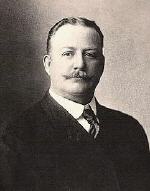
Frederic Sackrider Remington was a very significant artist, skilled as a writer and lauded as an illustrator, painter and sculptor. His subtle and powerful work made him the premier chronicler of the late nineteenth century American West. The son of a newspaper publisher, Remington was born in Canton, New York in 1861. He began sketching as a boy. After attending a Massachusetts military academy from 1876 to 1878, he entered the newly formed Yale University Art School in New Haven, Connecticut. His father's death in 1880 induced him to leave school and briefly take on clerical work in Albany, New York.
During a short journey West in 1881, Remington received a glimpse of the life and land that would influence and inspire the rest of his life. The trip, consisting of sketching, prospecting and cow punching from Montana to Texas, resulted in his first published illustration in Harper's weekly in 1882. In 1883, he bought a sheep ranch in Kansas, which served as a home base for more trips throughout the Southwest, where he sketched horses, cavalrymen, cowboys and Indians. Remington sold the ranch in 1884, and established a studio in Kansas City, Missouri.
Returning to New York City in 1885, Remington quickly became a successful illustrator, his work appearing in many publications. He began writing and illustrating his own books and articles as well, giving Eastern America what became the accepted vision of the American West. Wanting greater acceptance as a fine artist, he studied at the Art Students League in New York City for a few months in 1886. Remington began submitting his paintings to exhibitions, but his illustrations remained the primary source of his remarkable reputation. Remington did start winning prizes for his paintings in the early 1890s. His work consisted of visual narratives of the old West, with landscape secondary to the figure. In 1895, Remington produced his first bronze sculpture: The Bronco Buster (a cast in the Metropolitan Museum of Art), which immediately became popular and was followed by 24 other bronzes. His ability to exhibit a strong sense of life and movement in a three dimensional work was recognized.
After moving to a farm in Connecticut, where he established an art gallery and library surrounded by collected Western memorabilia and artifacts, Remington began to experiment with a kind of impressionism around 1905. Many American artists were attracted to the style during that period, but Remington never really ceased to be a realist.
Remington died in Ridgefield, Connecticut in 1909 after a sudden attack of appendicitis, leaving a legacy of more than 2,750 paintings and drawings and 25 sculptures from which multiple casts were made. In addition, he had written eight books and numerous articles about the American West, and served in the Spanish American War as a war correspondent. He was the most important artist ever to record the vanishing Western frontier.